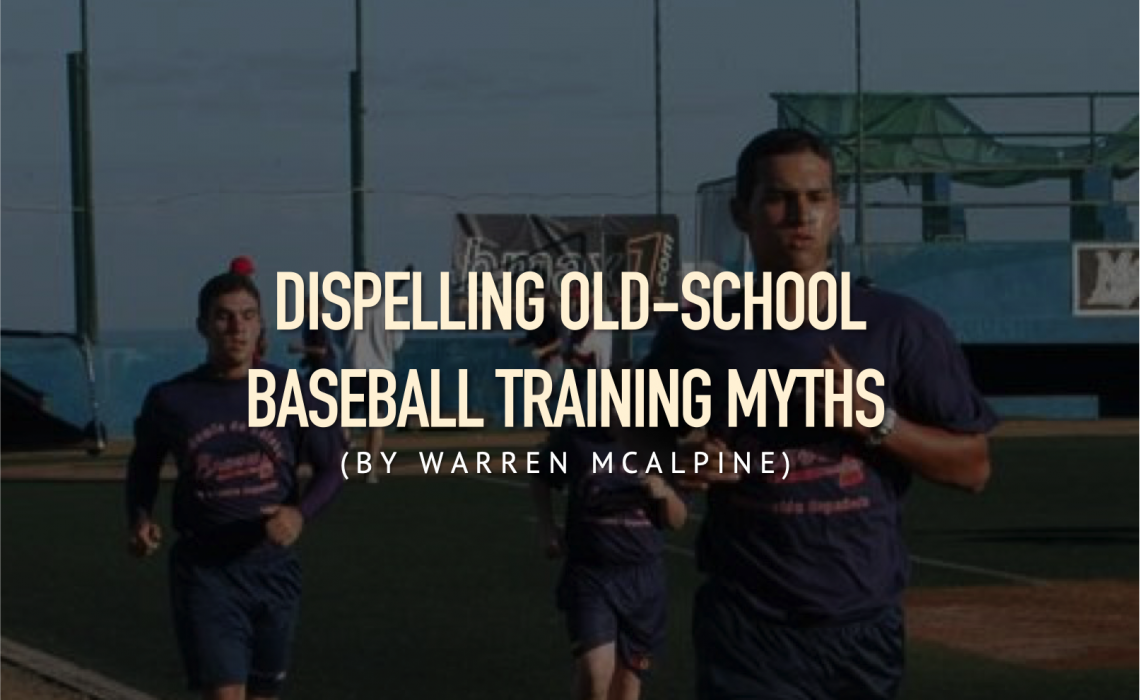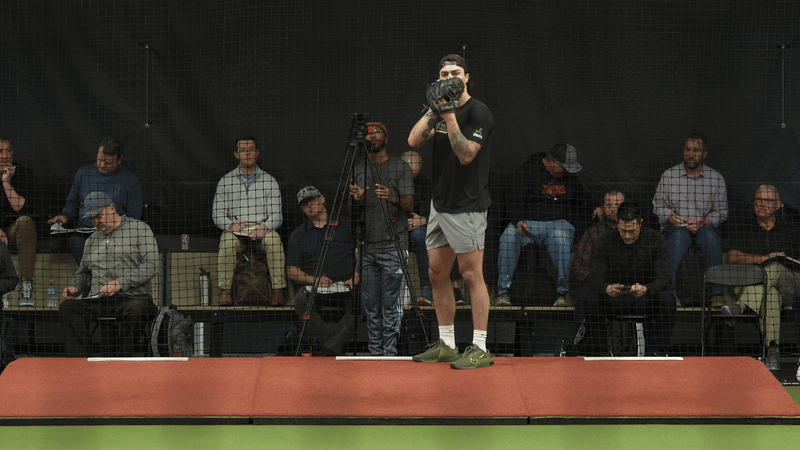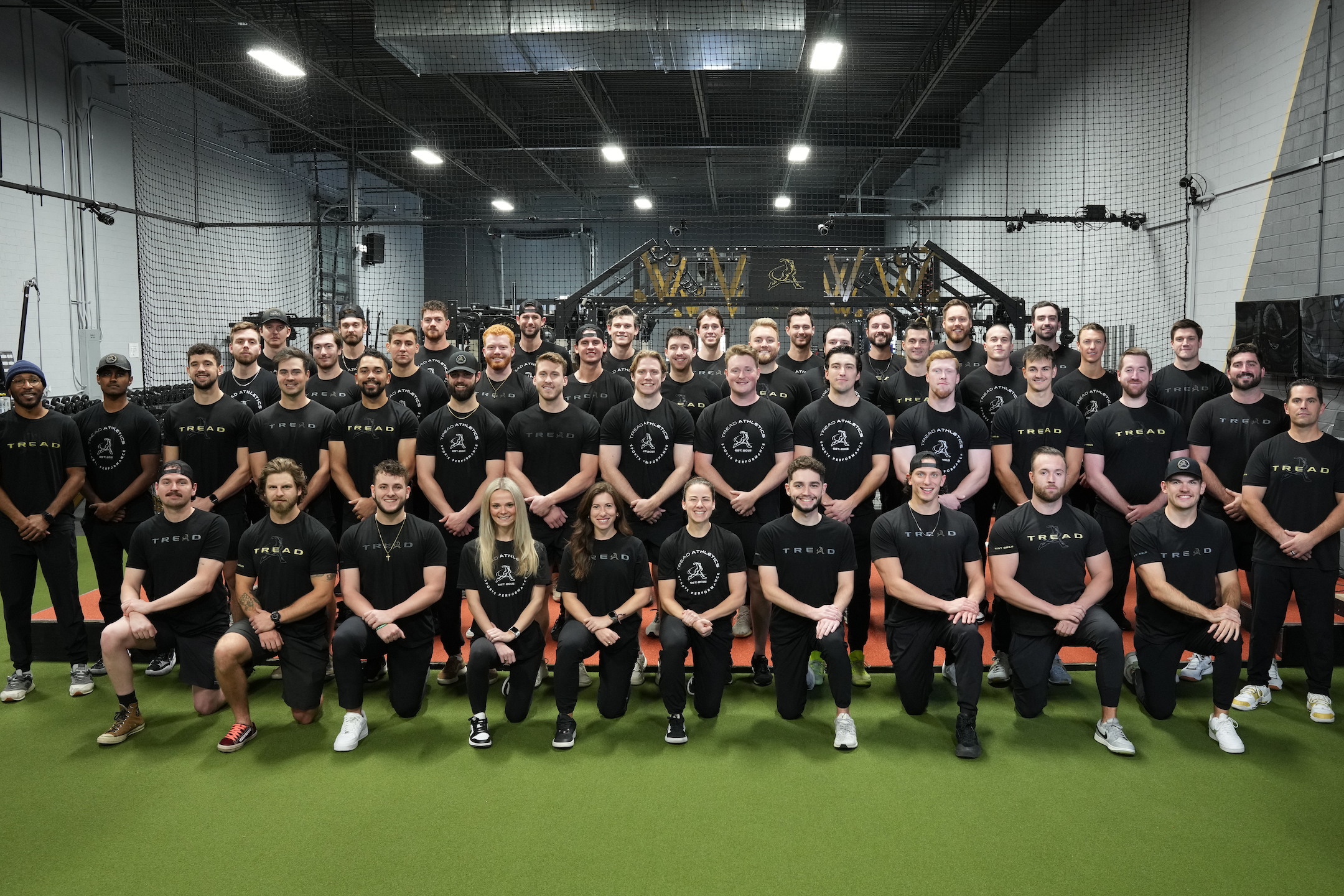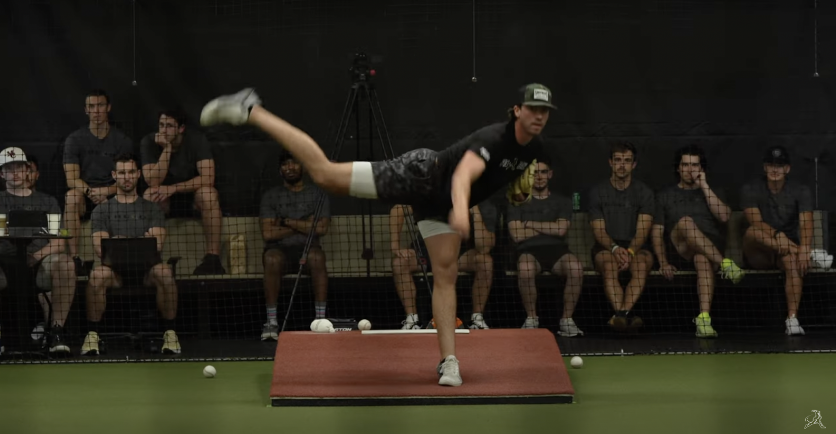by Warren McAlpine
During my adolescent years, I faced the typical barrage of pejoratives related to exercise training ranging from: “running long-distance is good for lactic acid removal after throwing,” to “squats are bad for your knees,” to “deadlifts will blow-out your back.” Unfortunately, I had not quite developed into the contrarian that I became in my late teens/early 20’s, and I took most of these remarks on bad faith. I did not regularly squat—if I did, it was on the Smith-Machine. I did not do my first deadlift until I was almost 19, and I even ran long-distance track thinking it would be good for my overall training development. Undoubtedly, I left some arm and bat speed in the tank by not training optimally.
The goal of this article is to dispel a few of these training mistakes, expose a few myths, and help you the reader make more informed decisions regarding your own baseball training.
Since a significant amount of old school coaches disparage weightlifting for baseball players, let us first address a training practice that they love to implement – long distance running.
Why did we run long distance in the first place and why do some coaches still use it?
Myth #1: Long Distance Running?
Or, A Quick Look at the History of Long Distance Running and Baseball
Claim #1: “It’s what we have always done”
This is important to consider as many of the coaches who rise/rose to their positions of authority did so by not rocking the boat with their own authorities. Baseball, to some extent, is a “good ole’ boy” sport, where it is considered subversive to do anything differently until the moment comes where everyone is doing something differently. Long distance running was the fitness fad of the 1970’s and bled into many American sports as a test of athleticism. As written in Edward Sears’s book, Running Through the Ages:
In the 1970’s the nation rapidly grew interested in participating in [running] as amateurs and athletes. This heath kick did not become a fad, but a movement. National athletic celebrities such as Steve Prefontaine and Joan Benoit stimulated interest in the sport. The union of Bill Bowerman and University of Oregon track and field with the creation of Nike marketed the activity. Publications taught and argued for the benefits of jogging. Historical and anatomical studies argued the natural skill of jogging that belonged to humans. Jogging was no longer done only for necessity but as a training suggestion (Sears, 2015).
Claim #2: “Running long distance removes lactic acid”
Unless the pitcher is throwing every 3 seconds, they are not operating within this window. Since a pitcher’s average rest interval is 15-30 seconds, we are not working in a frame where the accumulation of lactate is high. As David Szymanski points out in his journal article, Physiological of Baseball Pitching Dictates Specific Exercise Intensity for Conditioning:
High levels of lactic acid accumulation (>12 mmol/L) which do not occur while pitching, will return to baselines within 40-60 minutes after high-intensity exercise depending on whether one does active (35% VO2max) or passive (no exercise) post-exercise recovery. Potteiger et al. indicated that there were no differences between pre-pitching and post pitching blood lactate levels of 6 baseball players after throwing a 7 inning game. Therefore, there is no lactic acid to “flush” out of the pitcher’s arm 24 hours or longer after pitching (Szymanski 2009).
Claim #3: “But a lot of Major Leaguers run/ran poles!”
- Remember, these athletes were probably great despite or before they did anything. Don’t get in trouble with your coach [Ben’s Video here suggest ways to approach your coach on training]and like Ben has mentioned before, the surest way to ensure that your pitcher will not grow into his velocity is to do nothing. Coaches often do not know what to do when position players are getting reps, so instead of idle time, they feel running long distance will get the pitchers “in-shape.”
Editor’s Note: Warren is not advocating to disrespect your coaches and we all have done silly things in training but removing competing stressors for progress is paramount to recovery. See further discussion as to what “in-shape” means for a baseball player as we take a closer look at the energy systems utilized in the sport below:
Energy Systems (Bioenergetics)
A quick note on the graph: During the first 10 seconds you start sprinting/putting a muscle under tension, all three energy systems begin to work, but the first to fire up is the ATP-PCr system. This is the stored ATP within the working muscle. Once the ATP-PCr has started to run out, the glycolytic system ramps up and takes over for the rest of the next minute-90 seconds or so before it begins to run out of fuel. Glycolytic relies on energy converted from stored carbs (glucose) into ATP. Lastly, after about 90 seconds, you primarily start to rely on fats as a fuel source as you move into aerobic metabolism.
Remember, as a baseball player, you are essentially training the short-burst energy system (adenosine triphosphate phosphocreatine system ATP-PCr), occasionally tapping into glycolysis. Unless you are consistently hitting inside the park homeruns you will live within this energy system and this is where most of your training bouts should reside. Slow long-distance running makes you efficient at aerobic metabolism, something you will seldom if ever use during the duration of a baseball game. If programmed improperly, it will impair the improvement of your anaerobic metabolic system. In other words, baseball utilizes the alactic/anaerobic system, exclusively. Improving the utilization and efficiency of the aerobic mechanisms through long distance will not help and can even come at the expense of the anaerobic system (Bellar, 2012).
Myth #2: Squats are Bad for the Knee's
Or, why Squatting will Help You Develop the Capacity to Throw Gas
Claim #1 You shouldn’t squat with your hips below your knees, because that means your knees went over your toes.
It is important to remember that not all “squats” are created equally. Partial squats and something that looks like a squat might be bad for the knees. If the athlete consistently comes up on his or her toes while squatting, the athlete will have problems. If the athlete squats high and doesn’t appropriately load the hamstrings, the athlete will likely have knee problems. If the athlete squats in improper footwear, the athlete can develop problems. The idea that below-parallel squats are bad for the knees is not supported anecdotally or empirically. In fact, people without ACL’s can even perform full squats (McKean, 2010). Yes, full range of motion squats are more difficult because you are having to displace a load through a longer range of motion. You should squat unless you have some form of hip pathology limiting you from squatting, because a correctly performed squat is:
-
- A hip dependent movement, not a knee dependent movement.
The hips absorb and transmit most of the stress. The hip muscles consist of all the glute muscles, all the internal hip muscles, the adductors and the hamstrings. This large muscle mass adapts to squatting just like all muscles adapt to exercise. They grow as they get stronger and handle more volume.
2. A correctly performed squat, hips below the level of the knees, is an anatomically normal position. Even infants display an ability to squat below parallel.
Sometimes the Socratic Method (a form of cooperative argumentative dialogue between individuals, based on asking and answering questions to stimulate critical thinking and to draw out ideas and underlying presuppositions) is best for unearthing tenets:
(see dialogue below:)
“A 500 lb. squat has nothing to do with a 5-ounce ball!”
Or, “I don’t know any 500 lbs. squatters who can throw 95!”
First, how many people do you know who can throw 95?
Second, how many natural 500 lbs. squatters do you know?
Third, how many people do you know who went from 85 mph to 95 mph after they were 18 years old?
We now know more thanks to Tread Athletics!
When one thinks of 500-pound squatters, the first image that comes to mind to many people is a juiced-out meathead who can’t scratch his own back because he is so musclebound. In part, this is because there are so few 500 lb. squatters. Before the advent of YouTube finding a 500 lbs. full squatter was about as a rare as finding a four-leaf clover. And when you saw one, they were either on TV once every four years or were heavily musclebound. But here are some videos of drug-free lifters squatting 500 lbs. who aren’t overly musclebound:
Here is Call Florence, Tread Athletics Pitcher/Athlete, knocking on the door of a 500 lb. squat:
Call’s velocity went from: 82-85 to 92 while working with Tread.
Remember, you don’t necessarily have to squat 500 lbs. to be a 500 lbs. squatter. Most of your progress will come from working at 70-90 percent of your 1RM, anyway. At Tread Athletics, we rarely have our athletes squat above 85 percent because we have found that it is unnecessary to test our athletes 1RM when we have a good idea of where they stand.
Claim #2 “When they put a squat rack on the mound, we’ll start squatting!”
I had a coach tell me this when I was training Coan. Feeling the pressure to deliver and the clock ticking, insecurities naturally arose when Coan’s velocity was stuck in the low 80’s. Fortunately, I stuck with my intuitions and had Coan continue to squat trusting that the laws of physics would eventually deliver. Certainly, there was a delayed velocity response running in parallel with his absolute strength gains – but as forecasted, Coan’s velocity rose from 84 mph to 92 mph during his senior year of high school.
When a coach says something like this, the following is likely rooted within their psyche:
- They likely do not lift weights themselves
- The athletes they are surrounded by are pre-sorted through hard recruiting efforts to find elite arms, so they were never paid to develop velocity. Remember, skilled recruiters hunt the country (and sometimes other countries) for talent that is expressed. The less development that must be done on the velocity side, the more time they can spend on other things. The more likely they are to keep their jobs. It’s true that a lot of the genetic outliers do not need to do much to throw gas. Many have gotten to the upper echelons of throwing without ever touching a weight. But, remember, you’re likely not the genetic elite.
- Before the advent of YouTube and other media sharing devices, lifting in college strength and conditioning programs was atrocious. No one really held strength coaches accountable to their claims and numbers were all that mattered. Big numbers meant awards and promotions. Depth was to be forgotten and you would hear things like guys boasting 700 lbs. squats with 250-pound power cleans. If you are familiar at all with Olympic weightlifting, you will be able to discern that something had to be misaligned, as even the worst power-cleaners can clean half their back squat.
- They can’t coach the lifts properly; therefore, they avoid them all together.
Claim #3: “A 500 lbs. squat has nothing to do with a 5-ounce ball!”
At first glance, this seems like a fair argument. Why is there a relationship between moving an incredibly heavy mass and the art of accelerating an extremely light object? It is important to strip down the underpinnings.
- What are the pre-requisites to squatting 500 lbs?
- Lean mass >160 lbs. (our sweet spot for throwing gas). If you have a lean mass less than 160 and can squat ≥ 500 lbs. you are likely a high-class Olympic weightlifter and/or are very short.
- Nothing will put more pounds of lean tissue on your frame than full-squats.
- Strong legs (you’re not going to be able to split squat 250 lbs., if you can’t squat 250 lbs.)
- You may avow that a split squat is more highly correlated to throwing velocity than a back squat. But, I can assure you that unless and athlete has an injury or adverse mobility deficiency preventing him from back squatting, you are going to attain a 250 split squat much faster if you can squat 500 then if you only squat 250, or even 405 for that matter.
- Strong posterior chain (squats don’t just build the quadriceps)
- Strong “core”—defined as the interdependency of the abdominals, obliques, glutes and other midsection muscles that support the athlete during movement under load, or through space.
- Lean mass >160 lbs. (our sweet spot for throwing gas). If you have a lean mass less than 160 and can squat ≥ 500 lbs. you are likely a high-class Olympic weightlifter and/or are very short.
Take it to its extremes and then work backward.
What if the pre-requisite for playing division one college baseball was to throw 95 mph, not 90 mph?
- How would this change the training paradigm for teams?
- Claim #1: It’s not possible?
- I can buy that not everyone has the genetic and/or physiological capacity to throw 95 mph. But as we have stated ad nauseum this does not change how one would go about training to improve moving through space. First principles of physics still apply. As a pitcher, you are a system of levers moving through space and the critical path is the shoulder joint. It would be silly to injure your shoulder while weightlifting. Research estimates that somewhere between 70-75% of a pitcher’s velocity is generated from the upper half alone. But if you’re fighting for every mph, developing your lower half is a must for continued advancement into the upper stratums of baseball. In the end game, it is the 10%, then the 5%, then the 2% that separates everyone.
- Claim #1: It’s not possible?
- How would this change the training paradigm for teams?
While in recent years, we have noticed a positive uptick in form compliance, it still appears that the vast baseball population squats incorrectly. This might be why your coach is telling you not to squat.
Here is a link to our squatting instruction page:
Myth #3: Deadlifts will Blow-Out Your Back
Or, Why You Need to Deadlift
Performed correctly, deadlifts are good for your spine. Performed incorrectly, they are not. Orthopedic Surgeons and Physical Therapists are starting to shift their perspectives, and some are even suggesting deadlifts as a therapeutic exercise for some injured back patients (Berglund, 2015).
Training for Strength/Lean Mass Gains
- Quoting Mark Rippetoe, author of Starting Strength, “Athleticism is based on power, and as a result, athleticism is not very trainable – but strength is.” And, to take him a step further, not only is strength trainable, but lean mass gains are trainable. And, until they start making pitching a weight class sport, one would benefit from exploiting this. Finding a mechanical change that will illicit a 10 mph jump in pitch or bat velocity is much less likely to happen than by taking your deadlift from 205 to 405.
- Ben Brewster pointedly explains this in Tread’s overall development philosophy:

- Another item worth mentioning, we are finding that our athletes respond better at certain body fat percentages. This isn’t a novel discovery, but something worth noting. You are more likely to continue a strength and conditioning program when you feel good, so don’t get too fat. Consuming Krispy Kreme donuts may work when you’re 16 years old, but as you get older (and hopefully are still playing) it is going to be harder and harder to stay as lean as you were in your teens. See Coan’s article on playing weight.
Competing Resources:
- The margin for stress-adaptation:
- Unless you are a genetic rarity, continuing to add exercises will eventually be met with resistance to progress. Sometimes less is more. Accumulating more volume on the compound lifts is usually beneficial over time.
- Nearly everything works for a novice, much fewer things work for an intermediate, and few things work for an advanced lifter.
Training Adaptation
- You may be able to get away with long distance running for a while, but as a baseball player your ability to get stronger is already compromised by being a competitive athlete 4-7 months out of the year. Even the best strength training programs take months to produce good results. Don’t compromise this training window by doing silly things.
In response to the coach who offered, “as soon as they put a squat rack on the mound, we’ll start squatting.” I believe the appropriate rejoinder is – “as soon as mile-times start get recorded as earned runs, we’ll start running long distance.”
References:
Berglund L1, Aasa B, Hellqvist J, Michaelson P, Aasa U.,J Strength Cond Res. 2015 Jul;29(7):1803-11. doi: 10.1519/JSC.0000000000000837.
Bellar D, Judge LW. Modeling and relationship of respiratory exchange ratio to athletic performance. J Strength Cond Res. 2012;26(9):2484–2489
McKean MR, Dunn PK, Burkett BJ. Quantifying the movement and the influence of load in the back-squat exercise. J Strength Cond Res 24: 1671-1679, 2010
Potteiger JA, Blessing DL, and Wilson GD.The physiological response to a single-game of baseball pitching. J Appl Sport SciRes 6: 11–18, 1992.
Rippetoe, M., & Kilgore, L. (2011). Starting strength: basic barbell training. 3rd ed. Wichita Falls, TX: Aasgaard Co.
Sears, E. S. (2015). Running Through the Ages. Jefferson, NC: McFarland & Company,.







